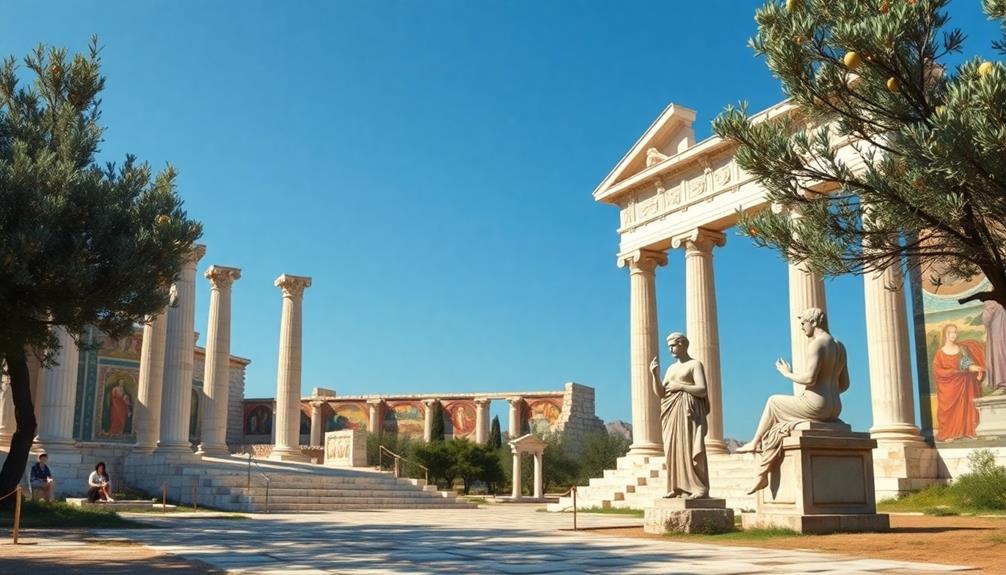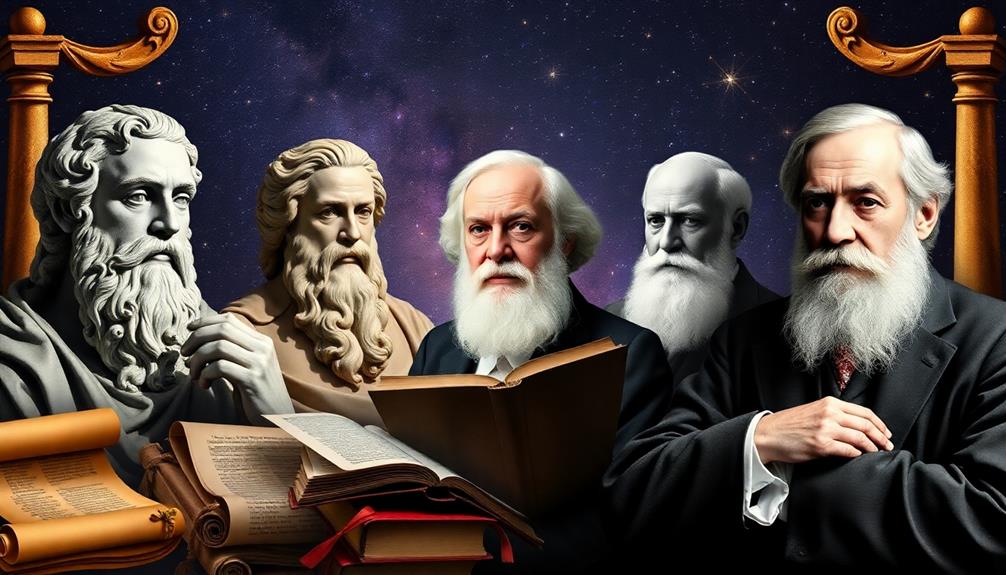In ancient Greece, you'll find that art and philosophy influenced each other profoundly. Philosophers like Plato criticized artwork for being mere imitation, while Aristotle celebrated its ability to capture deeper truths about human emotion. You see this tension between idealism and realism reflected in their works and the rich symbolism within Greek art. Techniques like mimesis and chiaroscuro helped artists convey complex human experiences. This interplay not only shaped the artistic landscape of the time but also laid the groundwork for future generations of creators. You'll uncover even more insights as you explore this fascinating intersection further.
Key Takeaways
- Ancient Greek philosophers, primarily Plato and Aristotle, profoundly influenced artistic expression, shaping concepts of beauty, essence, and societal reflection in art.
- Plato viewed art as mere imitation of the flawed physical world, arguing it is twice removed from truth and can mislead emotional understanding.
- Aristotle emphasized realism in art, advocating for the portrayal of deeper human experiences and emotions through the concept of mimesis.
- The transition from idealism to realism in art reflects a shift towards capturing the complexities of human experiences, as seen in Hellenistic art.
- Symbolism in ancient Greek art conveys philosophical and moral themes, enriching the understanding of human traits and cultural narratives.
The Role of Philosophy in Art
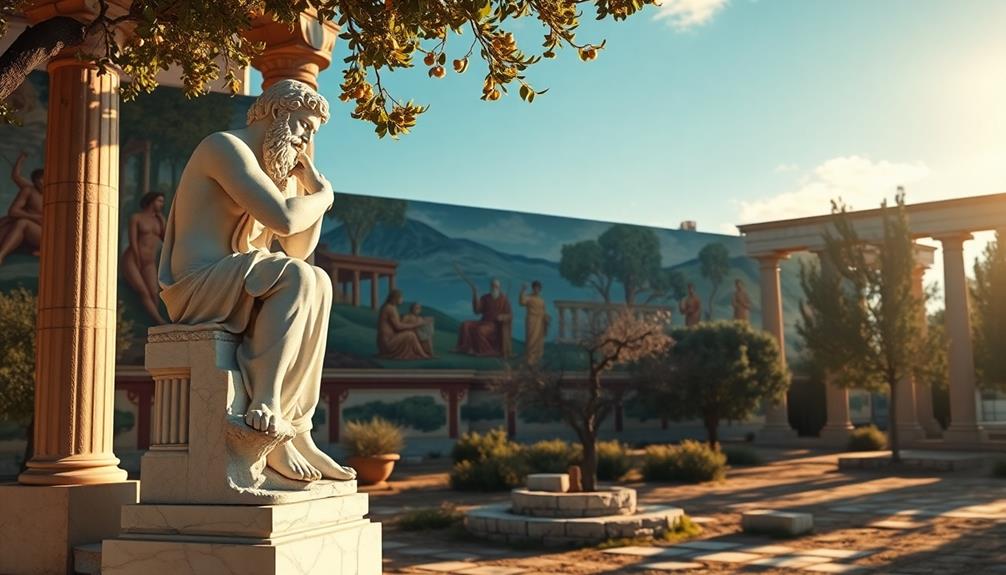
In ancient Greece, philosophy played a pivotal role in shaping art. You'll notice how philosophers like Plato and Aristotle influenced artistic expression profoundly. Plato viewed art as an imitation of the imperfect physical world, pushing artists to seek higher forms of beauty and universal truths. His allegory of the cave illustrates this journey from ignorance to enlightenment, guiding artists to create works that transcend mere physical imitation.
This philosophical exploration encourages deeper self-reflection, allowing artists to engage with the existential themes that resonate in their work and existential themes resonate.
On the other hand, Aristotle emphasized realism and relatability, encouraging you to capture the essence and deeper meaning of your subjects. He believed that art should evoke emotional and intellectual engagement, making the representation of inner human experiences a crucial component of your work.
The philosophical concept of "techne," meaning skill or craft, further established a close relationship between artistic practice and technological knowledge, shaping how you approach art production.
The legacy of this philosophical discourse continues to influence contemporary discussions on art, guiding you in exploring beauty, essence, and societal reflection in your artistic expressions.
Plato's View on Artistic Representation
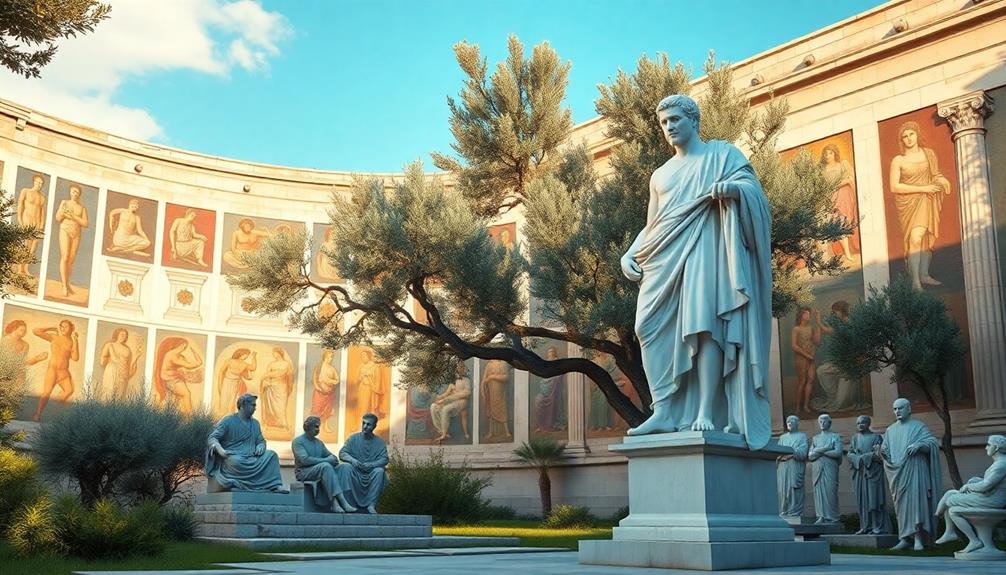
Plato challenges you to rethink how you see art, arguing that it merely imitates the flawed physical world.
In his Allegory of the Cave, he illustrates how most people only grasp shadows of reality, making art twice removed from the truth.
Allegory of the Cave
The Allegory of the Cave presents a powerful metaphor for understanding reality and artistic representation. In this allegory, Plato illustrates the journey from ignorance to enlightenment through prisoners who see only shadows on a wall, symbolizing our limited understanding of the physical world. He argues that art serves as an imitation of this flawed reality, making it twice removed from the truth found in the higher Domain of Ideals.
As you explore this concept, consider how artists act as illuminators, seeking to reveal universal truths. They guide viewers from the shadows of ignorance toward knowledge and enlightenment. The transformative potential of art lies in its ability to either deceive or inspire deeper contemplation.
| Aspect | Description | Implication |
|---|---|---|
| Limited Understanding | Perception based on shadows | Misinterpretation of reality |
| Artistic Imitation | Art reflects the physical domain | Distortion of true forms |
| Universal Truths | Art as a bridge to higher knowledge | Pathway to enlightenment |
| Transformative Potential | Art's role in shaping societal understanding | Influence on perception and truth |
In this light, art becomes an essential tool in our quest for truth.
Imitation vs. Truth
Artistic representation, as viewed through Plato's lens, reveals a complex relationship between imitation and truth. According to Plato, the physical world is a flawed imitation of true, ideal forms that exist in a higher domain. This perspective positions art as an imitation of an imitation, leading him to argue that artists merely reflect our shadowy perceptions without accessing genuine knowledge or truth.
In his Allegory of the Cave, he illustrates how most people reside in a world of shadows, with artists creating representations that are twice removed from reality.
Plato's philosophical inquiries prompt you to reflect on the value of art, as he believes it can mislead and distract individuals from pursuing true understanding. He contends that art evokes emotional responses that detract from enlightenment.
Despite these criticisms, he acknowledges art's transformative power, urging artists to aspire toward higher forms of beauty that align with the ideals regarding the domain of Forms.
Aristotle's Perspective on Art
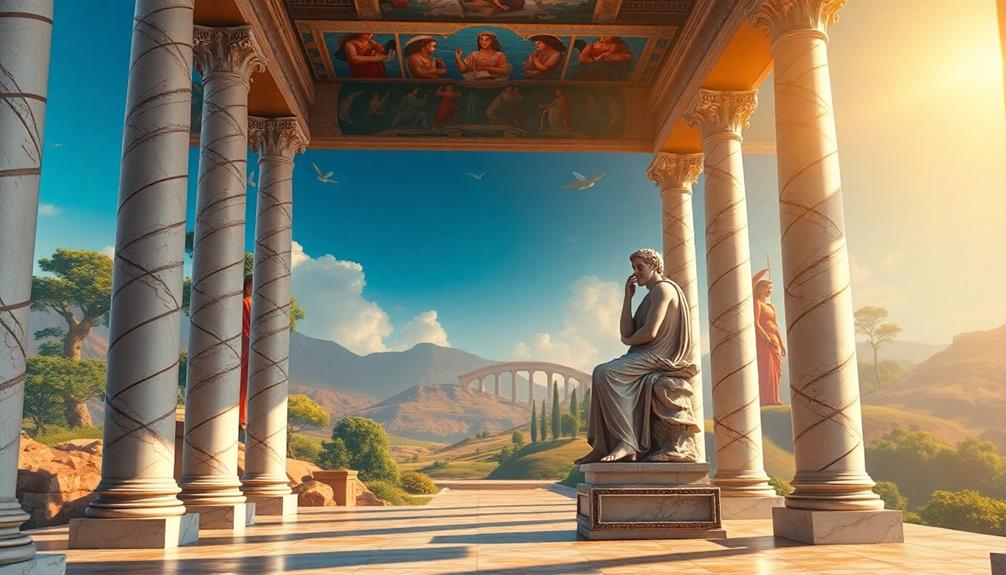
When you explore Aristotle's perspective on art, you'll find he emphasizes capturing the essence of the observable world.
He believed that art should reflect realism while revealing deeper truths about human experiences and emotions.
This approach not only shapes artistic representation but also guides viewers toward understanding and emotional release.
Essence in Artistic Representation
In exploring the essence of artistic representation, Aristotle's perspective reveals a profound understanding of how art connects with human experience. He emphasized that art and architecture should capture the essence of human experience, encouraging artists to probe beyond mere appearances.
For Aristotle, mimesis—art's imitation of nature—was not just about replicating what you see; it was about expressing the deeper truths behind the subjects portrayed. He believed that a successful artwork reflects the observable world while also evoking emotional connections with its audience.
Ancient Greek philosophers like Aristotle argued that art should resonate with viewers, prompting them to confront their emotions and moral complexities. His concept of catharsis in tragedy illustrates this, suggesting that experiencing art can lead to a greater understanding of human emotions.
Aristotle's balanced approach between realism and idealism continues to influence contemporary discussions about art's purpose today. By appreciating the essence of subjects, artists can create works that resonate with our shared human experience, fostering a deeper connection and understanding among people across time and cultures.
Realism and Human Experience
Realism plays an essential role in understanding human experience through Aristotle's lens on art. He believed that art should capture the essence of subjects, urging you to look beyond mere appearances. Aristotle's concept of mimesis, or imitation, emphasizes that art shouldn't just replicate reality; it should reflect deeper human experiences and emotions. By doing so, art resonates with you on both an emotional and intellectual level.
Aristotle's approach to realism isn't just about depicting the observable world. It encourages you to connect with the art on a more profound level, seeing it as a mirror that reveals inner truths and the complexities of the human condition. This philosophical inquiry into beauty allows you to relate to the artwork, fostering a sense of connection with the artist's intentions.
Moreover, Aristotle's perspective balances the real and the ideal, making art a crucial tool for exploring life's intricacies. Through this lens, you can engage with art as a means of understanding not only the world around you but also your own experiences and emotions.
Ultimately, realism in art becomes a powerful way to navigate and express the multifaceted nature of human existence.
Comparing Idealism and Realism

Art in ancient Greece reveals a fascinating tension between idealism and realism, each offering unique perspectives on representation and creativity.
Plato's idealism champions the notion that true art imitates perfect forms, while Aristotle's realism emphasizes capturing the essence of the observable world. This contrast is beautifully illustrated in Raphael's fresco, The School of Athens, where both philosophies engage in a visual dialogue.
Here's how you can differentiate between idealism and realism:
- Focus: Idealism prioritizes abstract perfection, while realism emphasizes emotional relatability.
- Aesthetic vs. Experience: Idealist art seeks higher truths through beauty, whereas realist art mirrors human experiences.
- Representation of the Human Figure: Idealism often depicts an idealized human form, while realism captures the nuances of human life.
- Influence: The philosophies of Plato and Aristotle continue to shape contemporary art discussions, steering the balance between ideal beauty and realistic representation.
As you explore ancient Greek art, consider how this shift from idealism to realism marks a significant change, highlighting the growing importance of naturalism and emotional expression, especially in Hellenistic art.
Symbolism in Ancient Greek Art
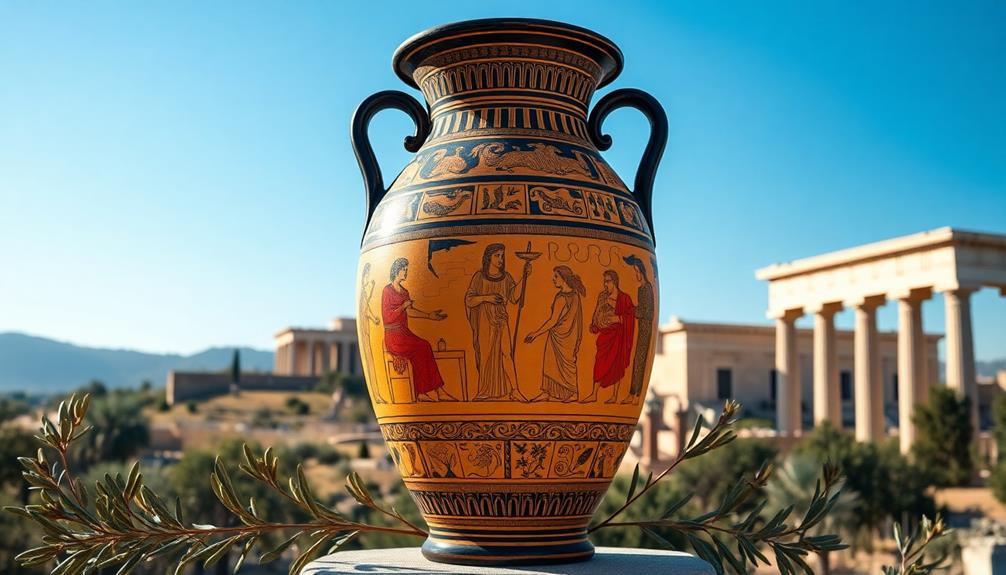
Ancient Greek art is rich with symbolism, providing insights into the philosophical and moral frameworks of the time. You'll find that the artwork often conveys complex ideas through recognizable iconography. For instance, the olive tree symbolizes peace and prosperity, while the laurel wreath signifies victory and honor. These symbols reflect the societal values that were essential to the ancient Greeks.
Mythological figures like gods and heroes are depicted not just for storytelling but to represent human traits and ideals. This reinforces cultural narratives and moral lessons, showcasing the virtues and beauty that the society admired.
The use of color and form in pottery and sculpture also carries symbolic meanings—each hue can represent specific emotions or states of being, adding depth to the narrative.
Moreover, everyday life scenes capture labor or celebration, imbuing them with significance that mirrors the community's values. These artistic expressions create a dialogue about the human condition and philosophy, allowing you to explore how ancient Greeks viewed virtue and beauty in both art and life.
Through these symbols, you connect with the essence of their philosophical discourse.
Techniques of Classical Art
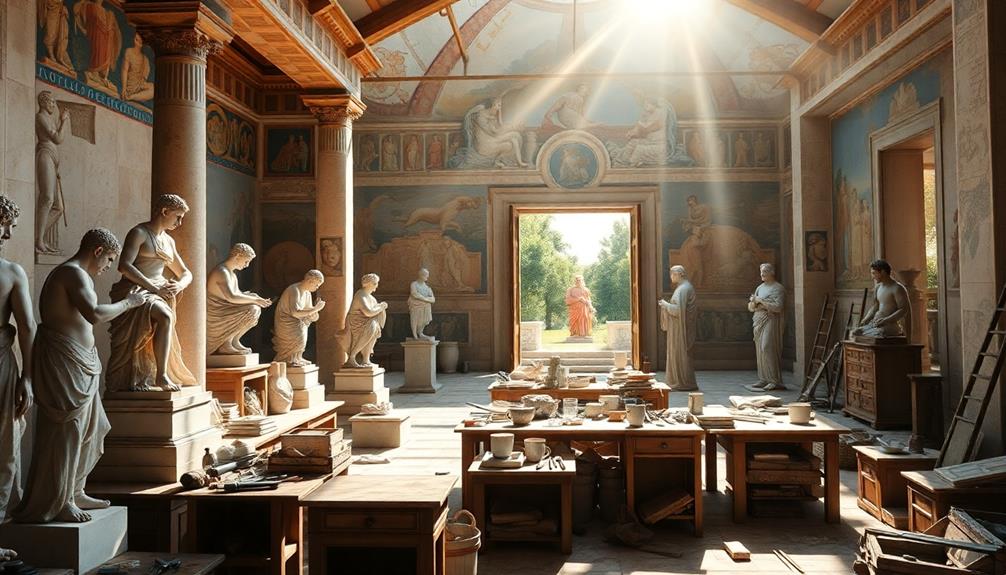
Employing a variety of techniques, classical artists achieved remarkable levels of realism and expression in their work. Central to ancient Greek art were methods that focused on the proportions of the human body and the natural world.
Here are some key techniques they used:
- Canon of Polykleitos: This set of ideal proportions defined the human figure, influencing countless sculptures.
- Chiaroscuro: By employing light and dark contrasts, artists created depth and volume, enhancing the overall visual experience.
- Contrapposto: This technique positioned figures in a natural stance, distributing weight on one leg, which added realism and a sense of movement.
- Mimesis: Artists practiced this imitation of nature, endeavoring to capture the essence of reality, making their works resonate with life.
These techniques not only highlighted the skill of the artists but also reflected philosophical ideas about beauty and the human experience.
As you explore these methods, you'll appreciate how classical art not only represented the physical form but also aimed to evoke deeper emotional truths, bridging aesthetics with philosophy.
Influence of Philosophical Movements
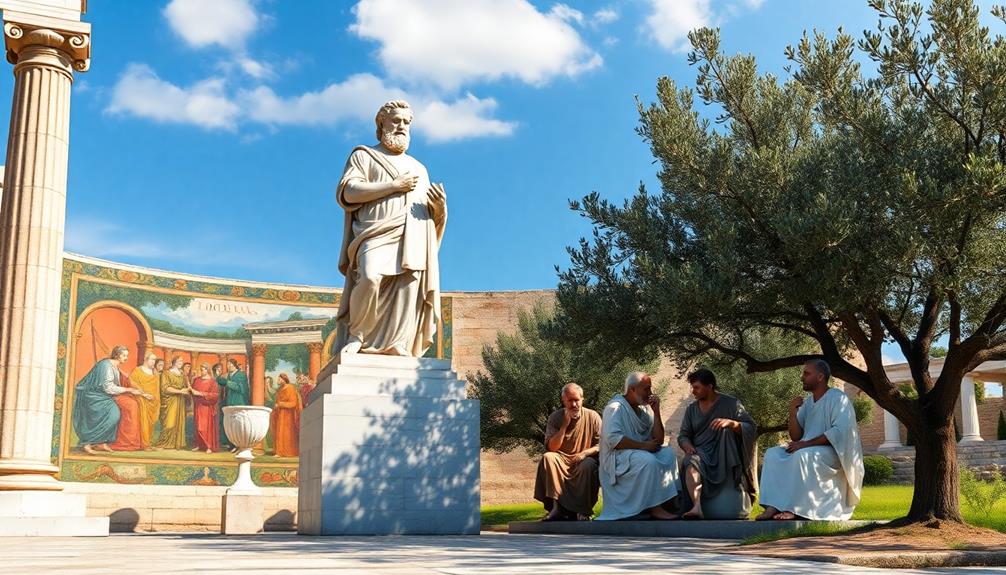
Exploring the influence of philosophical movements on classical art reveals how deeply intertwined these disciplines were in ancient Greece. The Ancient Greeks, with their rich philosophical traditions, shaped art theory in ways that resonate even today.
Platonic Idealism encouraged artists to pursue perfect forms, leading them to create sculptures that depicted the human body with mathematical precision, embodying idealized beauty.
In contrast, Aristotle's concept of realism pushed artists to focus on observation, capturing the essence of human experience. This shift resulted in a greater emphasis on emotional expression, particularly during the Hellenistic period, where artworks became more relatable and engaging.
Stoicism also played a significant role; its focus on virtue and rationality inspired artists to reflect themes of morality and human endurance, portraying resilience in their works.
Moreover, principles like the Golden Ratio, rooted in Pythagorean thought, guided artists in achieving aesthetic harmony and proportion, evident in masterpieces like the Parthenon.
The interplay between skepticism and art prompted critical examination of beliefs, allowing artists to explore existential themes, challenging viewers' perceptions of reality and truth.
Consequently, philosophical movements profoundly influenced the evolution of art in ancient Greece.
Legacy of Greek Thought in Art
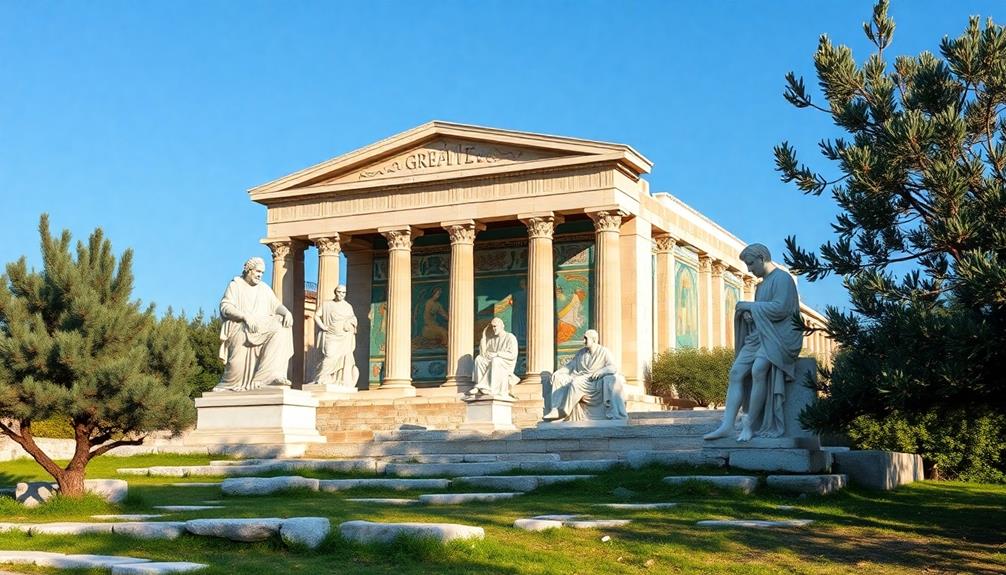
The rich legacy of Greek thought continues to shape the world of art, influencing both creators and audiences alike. As you explore this legacy, you'll find that key philosophical ideas from ancient Greece have woven themselves into the fabric of artistic expression.
Here are some significant aspects to take into account:
- Ideal Forms: Plato's concept of ideal forms encouraged artists to aim for perfection in their work, impacting how beauty was perceived.
- Balance and Proportion: The Canon of Polykleitos established the ideal body proportions, reinforcing the idea that symmetry reflects harmony and beauty.
- Artistic Techniques: Techniques like contrapposto and chiaroscuro emerged from philosophical inquiries into realism and emotional expression, enhancing depth in art.
- Mathematical Principles: Structures like the Parthenon exemplify how mathematical ideals, such as the Golden Ratio, connect aesthetic beauty with philosophical thought.
Ultimately, the legacy of Greek thought invites you to contemplate the nature of beauty, emphasizing the ongoing relevance of balance and proportion in artistic practices today.
It's this interplay of philosophy and art that creates a lasting impact, inspiring generations to come.
Frequently Asked Questions
What Is the Connection Between Art and Philosophy?
Art and philosophy connect through shared inquiries into existence, beauty, and morality. When you create or contemplate art, you're often engaging with philosophical ideas, reflecting on deeper meanings and the human experience in profound ways.
How Does Philosophy Relate to Ancient Greece?
When you think about philosophy in ancient Greece, you're diving into a domain where thinkers like Socrates, Plato, and Aristotle challenge norms, question existence, and shape ethics, influencing countless generations with their profound insights.
Why Was Art so Important in Ancient Greece?
Art's essential in ancient Greece because it reflects societal values, emphasizing beauty and harmony. You see it as a means of personal expression and a way to explore deeper philosophical questions about existence and morality.
What Was the Concept of Art in Ancient Greece?
In ancient Greece, art's like a sculptor chiseling marble; it's a skill, a reflection of nature's beauty. You'd see mimesis at play, where artists captured reality while conveying deeper truths, aiming for ideal harmony.
Conclusion
In exploring the intersection of art and philosophy in ancient Greece, you uncover a rich tapestry woven with ideals and realities. Just like a sculptor chisels away at stone to reveal beauty, the Greeks shaped their understanding of existence through art. Their legacy continues to inspire, reminding you that every brushstroke and philosophical inquiry invites deeper contemplation. Embrace this dialogue between art and thought, for it's a journey that enriches both the mind and the soul.
